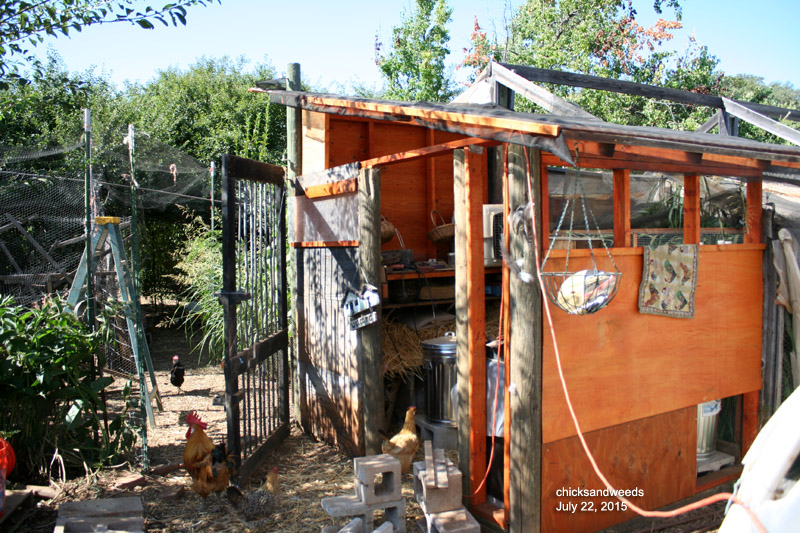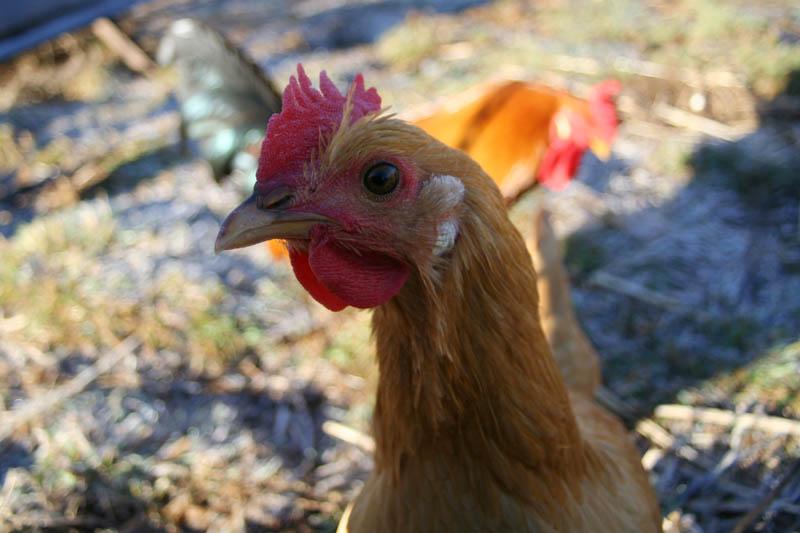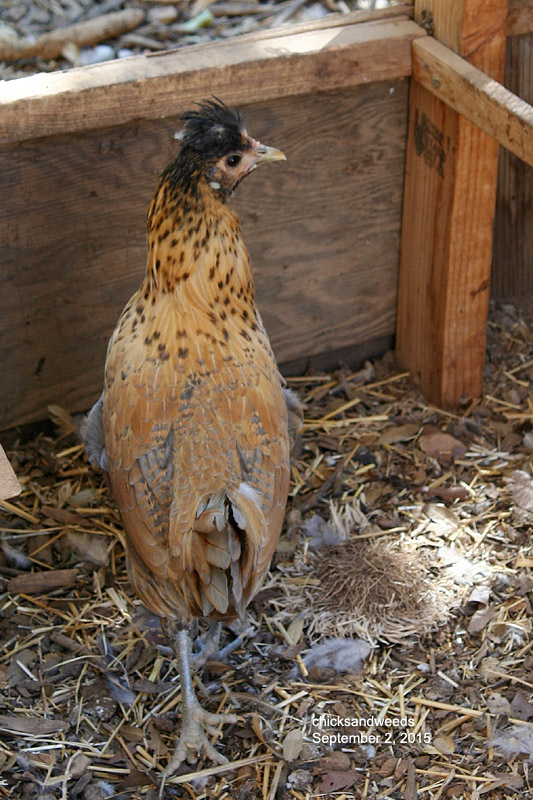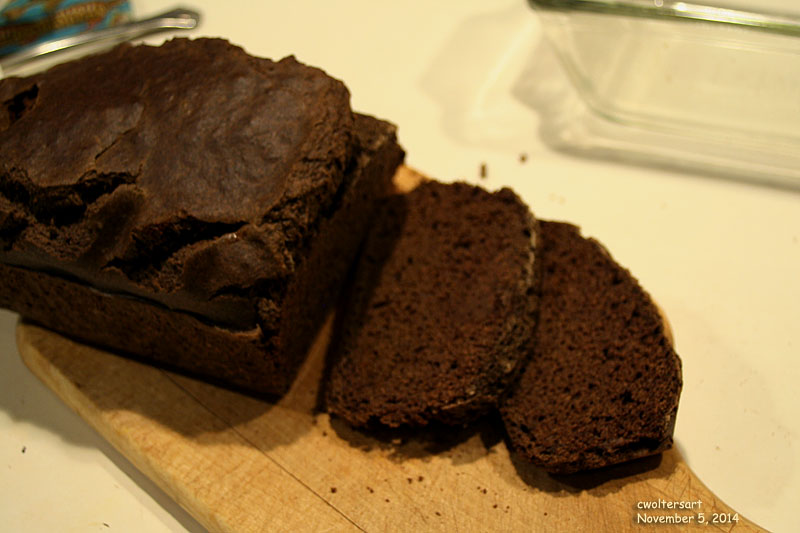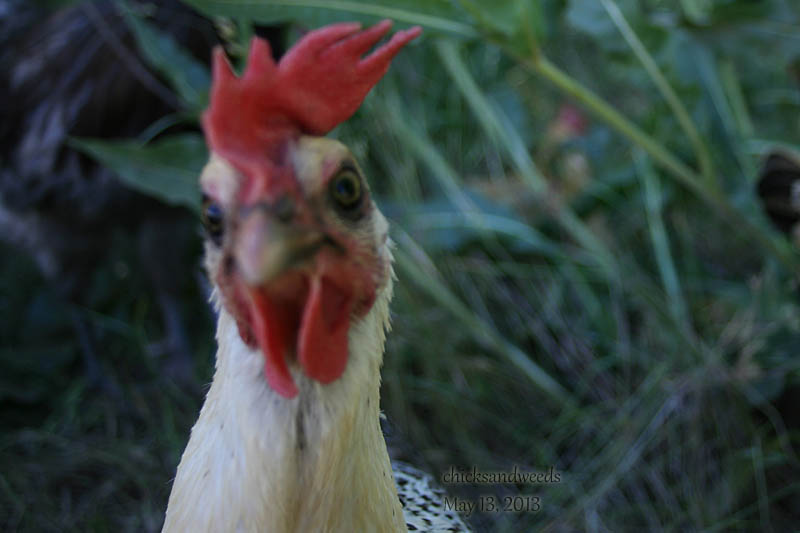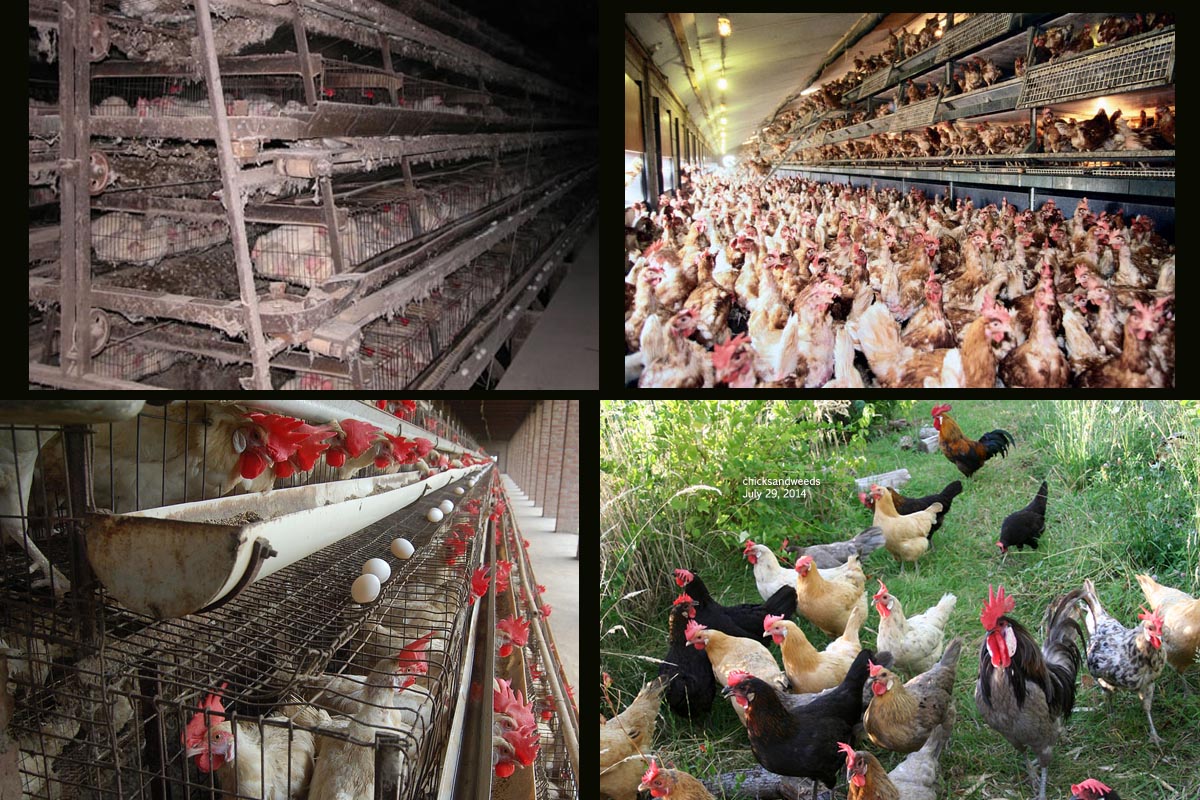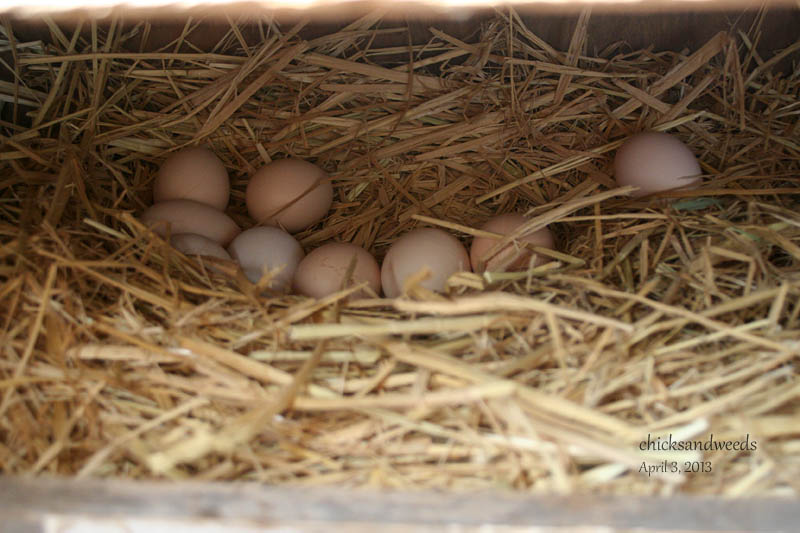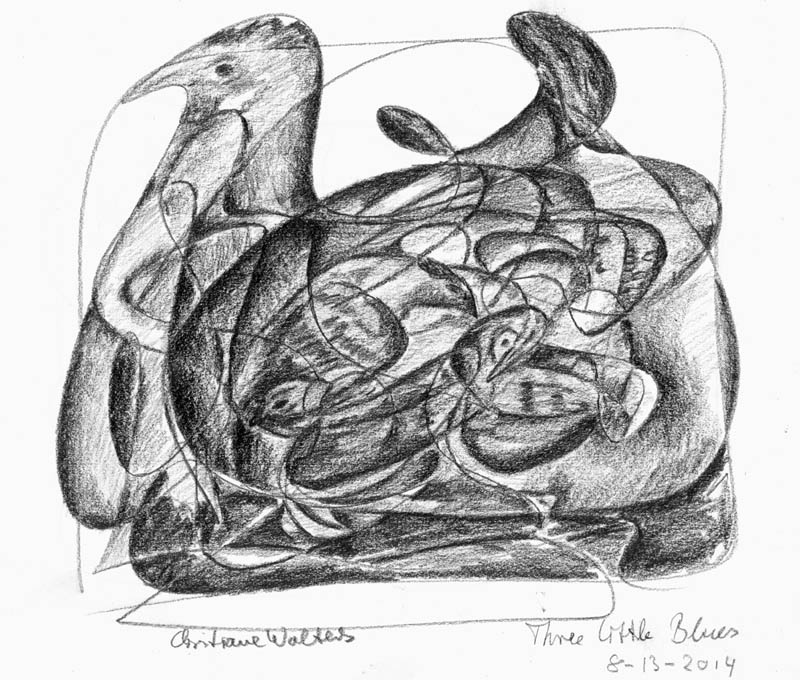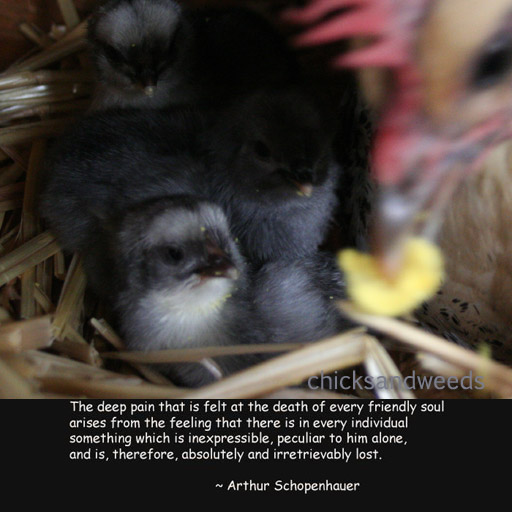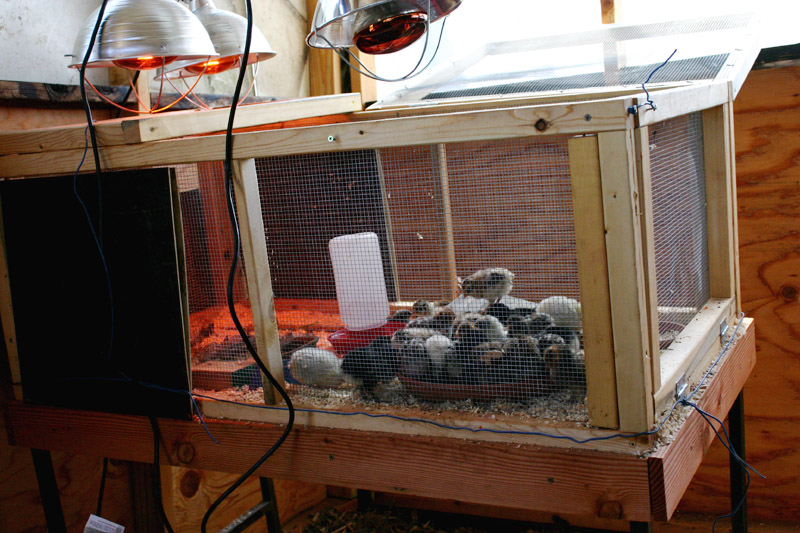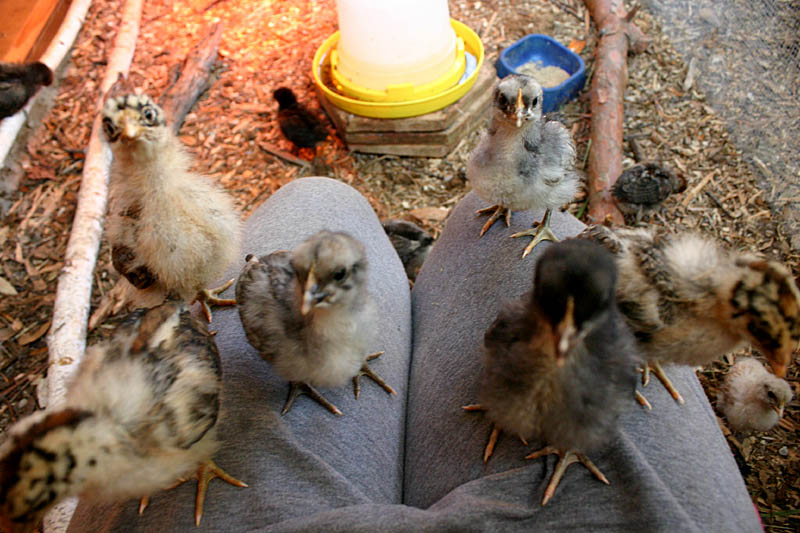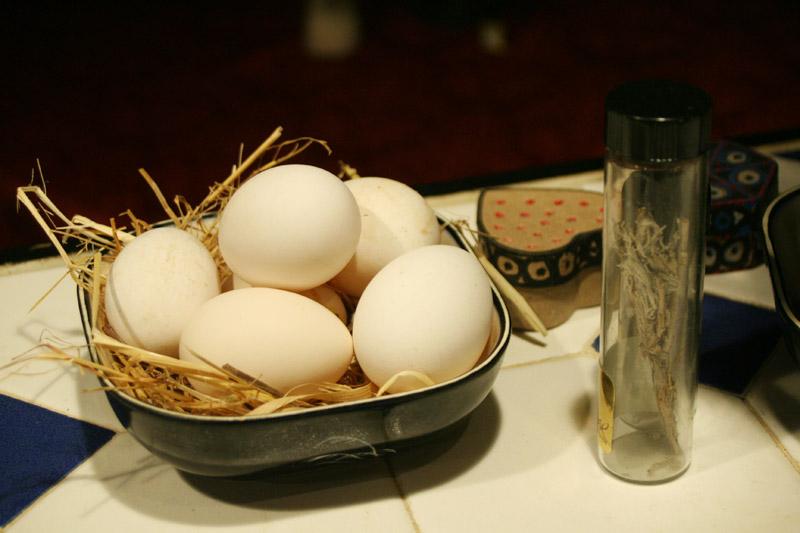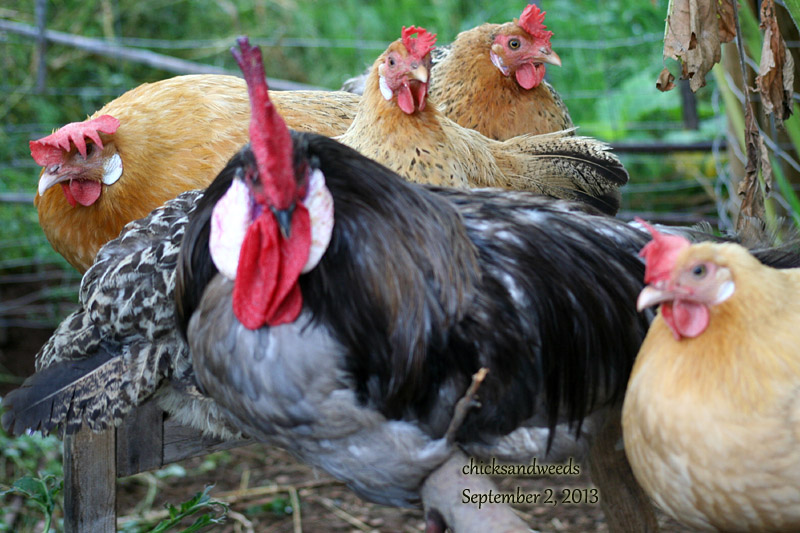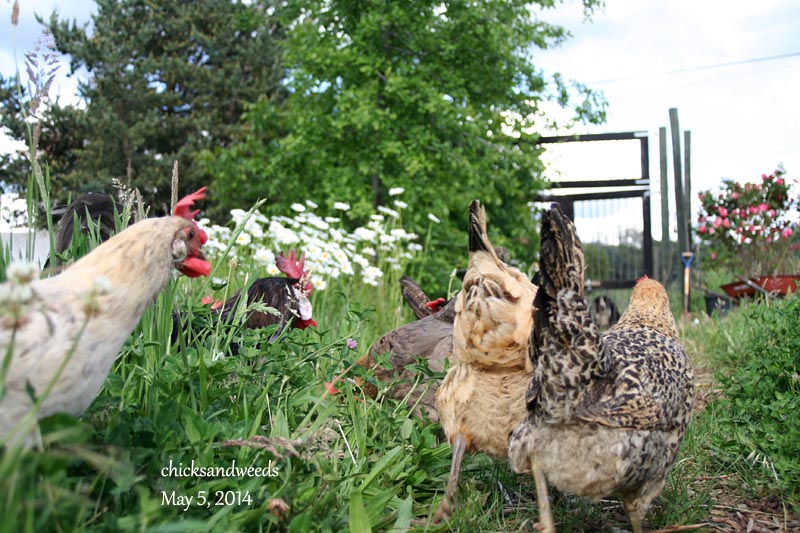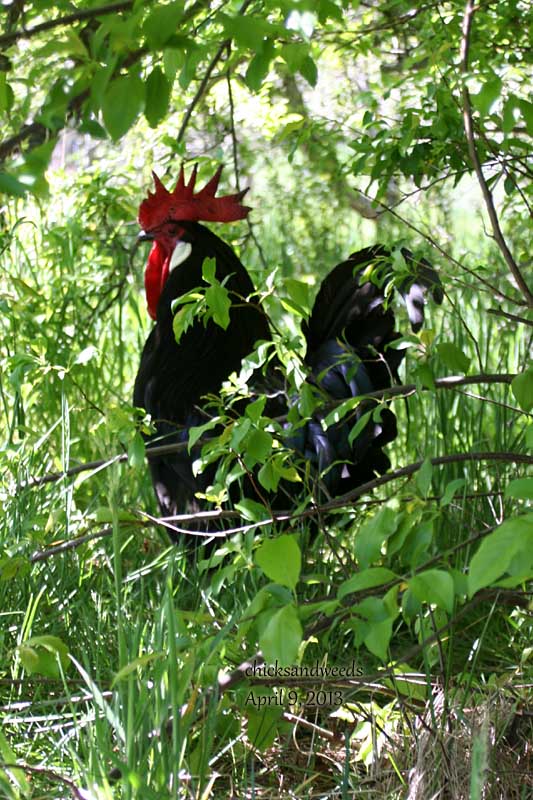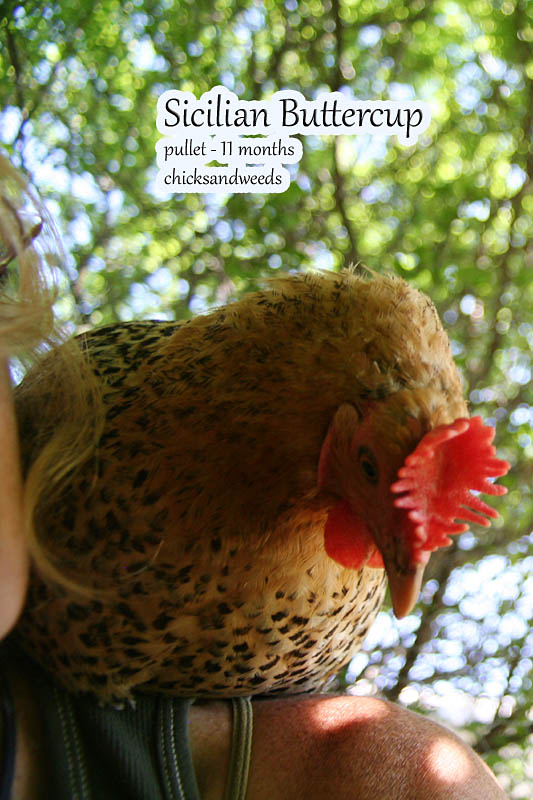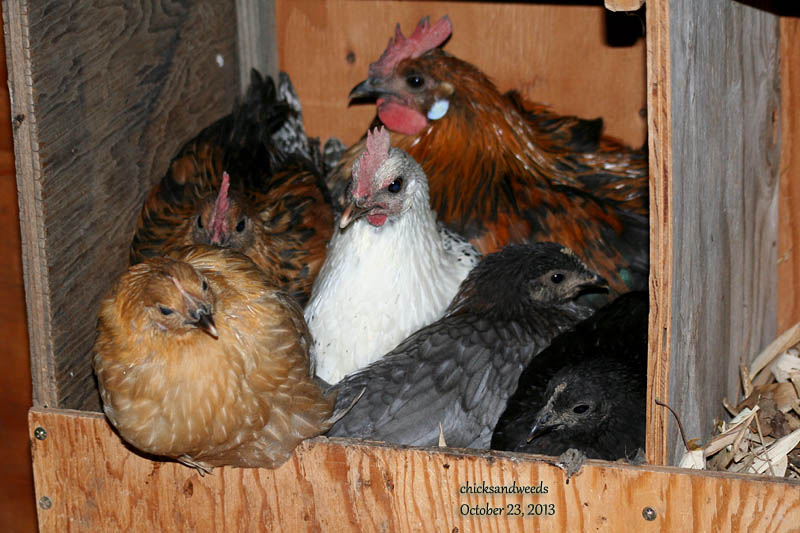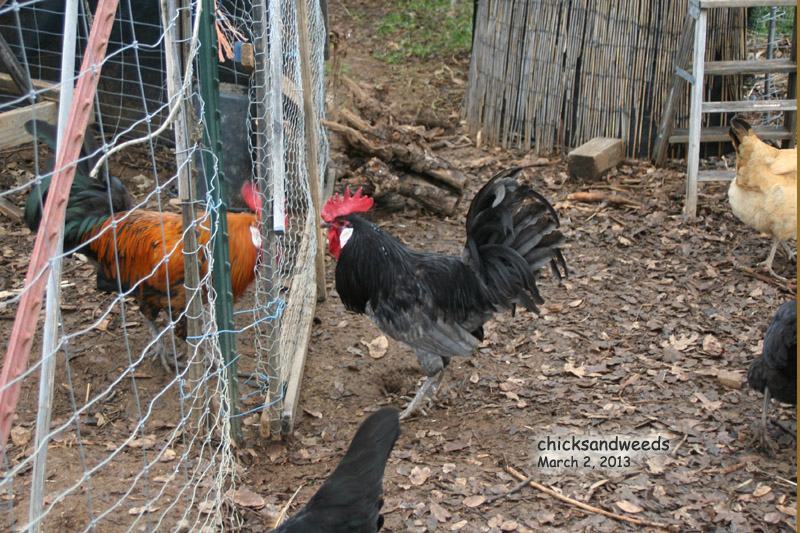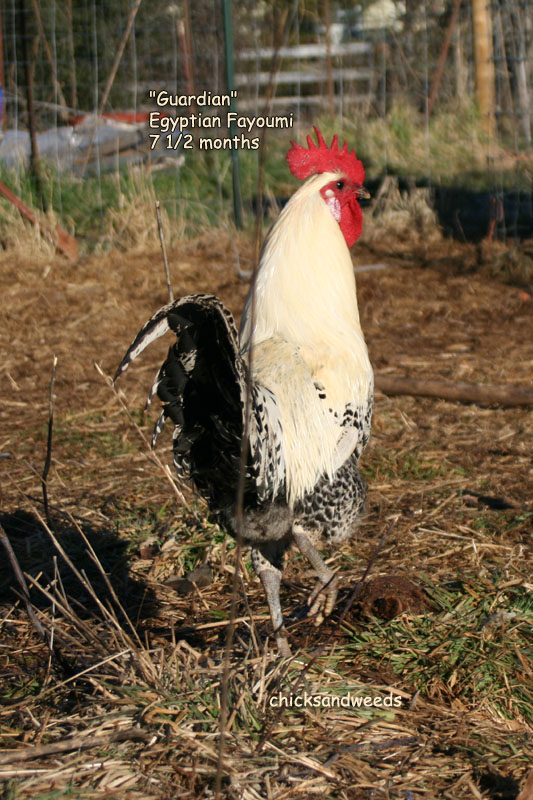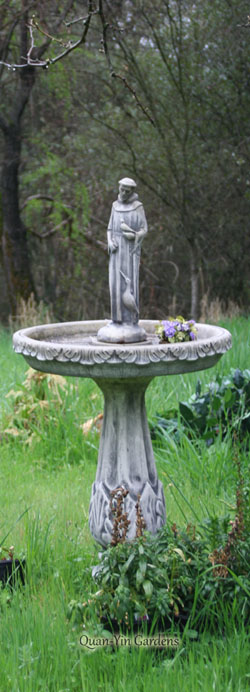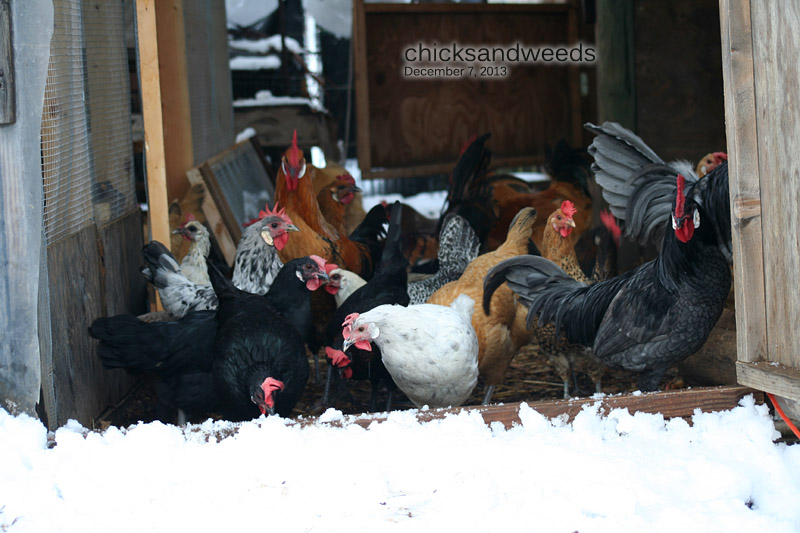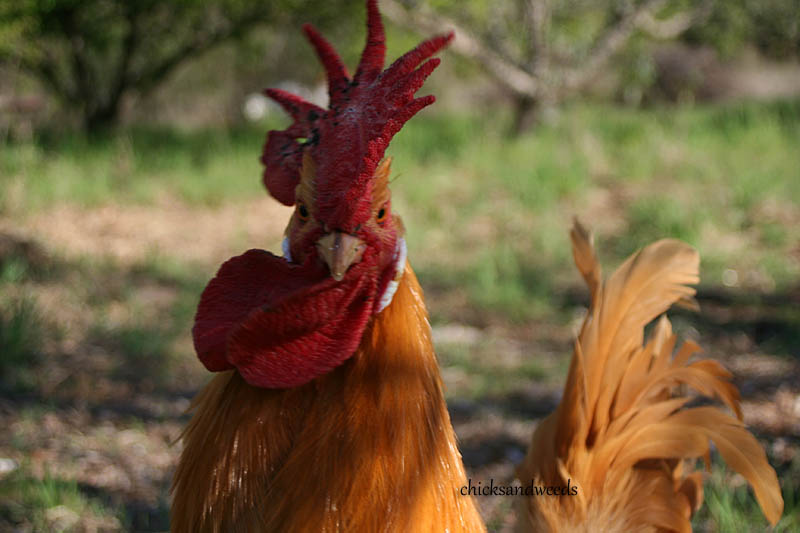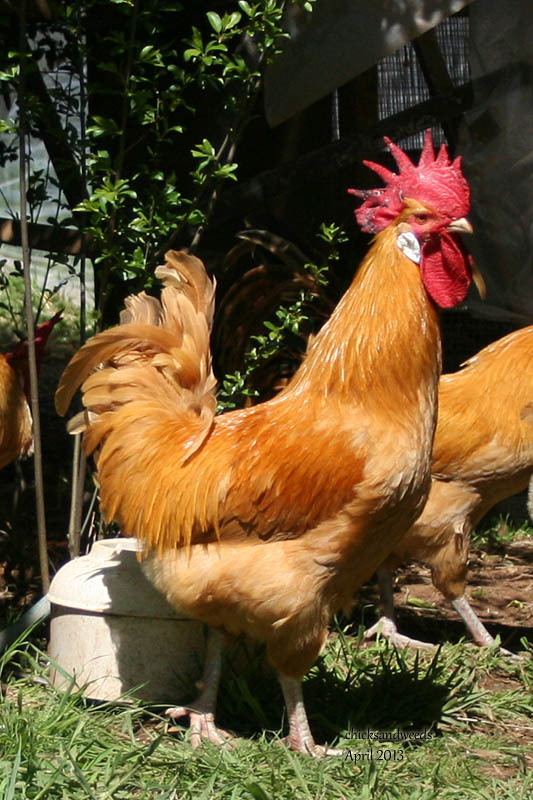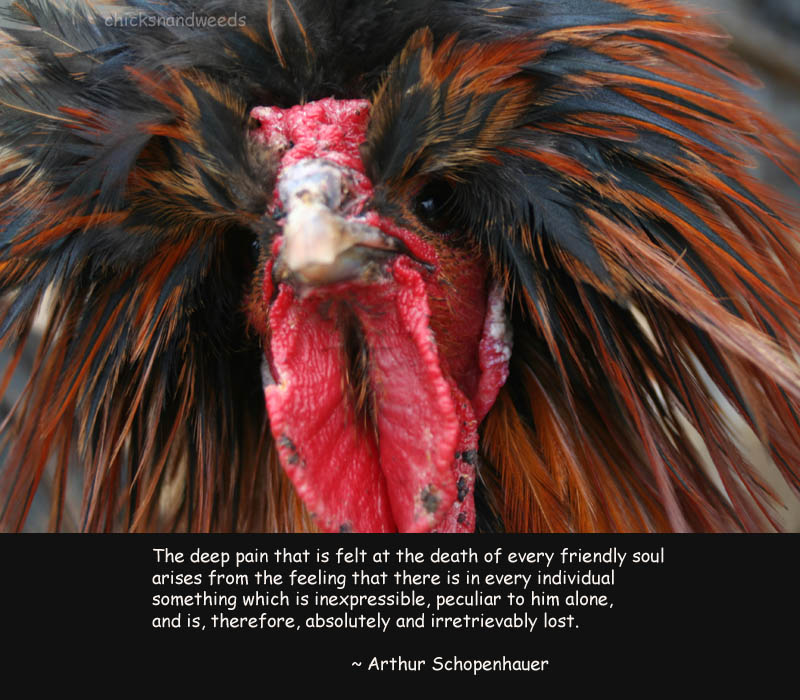How to deal with roosters
This is a bit lengthy and originated from a conversation over the internet. (I first wrote it for the blogspot blog, but since the surveillance revelation, I am moving stuff to a website). This article does contain examples for certain behaviors of some of my roosters. If you plan to raise roosters – you might find it helpful. (at the time of this transfer, we are another 4 months out – and still no problems with roosters.)
When dealing with roosters, a lot has been written about rooster to rooster aggression and rooster to human aggression. This post is more focused on the rooster to human relationship. I wanted my roosters friendly towards me at all times – at the very least, I did not want to look over my shoulder walking in chickenland.
Given my current experience, if you have enough space and females, and tolerant neighbors, you can keep a LOT of roosters without much if any trouble.
Rooster behavior varies with breed/genetics, age, season, absence or presence of females, food supply, living space and conditions, time of day, flock dynamic and how they are treated.
I tip ahead of time: figure 1 rooster per 7-12 hens – if you have several more roosters, you might want to consider a rooster pen with a separate pop door to a rooster area – no later that 3 1/2 months. Some roos mature early, some only a few months later. It is not that the roosters are a problem with you or each other – it is difficult on the hens to have so many on them, especially as the pullets don’t mature all on the same day and the few that mature early have to bear them all. If you raise dual purpose chickens and have straight runs – separate the roos out at 2 months – or earlier if you can tell.
I think roosters are killed for space, noise and because they do not lay eggs and cost money to feed and not all of them are needed to raise chicks or for flock protection, so they can be food. They need not be killed for aggression, but that takes a certain way to raise them.
Jumping ahead:
There are 2 ways to see ourselves with roosters that I find acceptable to me and work with because it means never to fight with them or hurt them:
Both ways do require flock/rooster awareness and observation.
1 – we are humans and not chickens, let alone roosters that need to fight and they learn to see us as a benign presence. We don’t need to fight them because we don’t antagonize them or treat them as roosters competitors – but give them the respect and space that a rooster needs – and walking in “chicken Tai-Chi”.
2 – we need to be like top roosters to them – but – we don’t have to accomplish that by fighting them…but at the first sign of them trying to assert dominance, we are either steady, ie just stay put – or ward them off with a step or two towards them. Some folks use a stick as an extended arm. We keep them at a distance and don’t try to make them pets. Also, isolation can be tried. They tend to be much more demure upon re-rentering a flock after a day or 2 in a cage or crate. Picking them up and releasing them when calm is another way to getting them used to us not being a threat.
Since I also wanted friendly roosters who also come to me for treats …. this was going to be a balance game.
In 9 months I raised 32 roos of 6 different breeds (Sicilian buttercups, Egyptian Fayoumi, Blue Andalusian, Buff Catalana and Buff Minorca, Golden Polish) and 21 hens in a pretty small area – …and here are some things regarding behavior I have learned so far (no experience yet with broody hens, I hear they get pretty feisty and their peck hurts a lot).
General things to remember about chickens and roosters – based on observation and experience and because it has worked very well. All my roosters turned out friendly and all come for treats.
0 – chickens are amazing and can open your heart – AND – always remember, they are chickens and will act according to their programming and depending on genetics, season, temperament, hormones and circumstances …there can be surprises….never take it personally.
1 – beaks and feet – as weather gets warm, I like to wear just tank tops and sandals …but …when in the chicken world…that does not work for my skin because their little feet are no longer soft baby feet. Even them innocently flying on my bare shoulders I have gotten scratched bloody and still have the scars from that. Also, I wear a cap when I spend time with them at all, especially if I sit or crouch …because them landing on my head …hurts like hell since they got bigger than the little peeps they were. -> be aware of their feet on your skin. Chickens have a lot of sharpness in their beaks ..your eyes are NOT safe around them …be aware. Gums are not as critical, but it DOES hurt when they go for your teeth.
2 – bending down, sitting or being in a crouched position appears to be an invitation to fly on you …no matter what the intention.
3 – better to not show bare skin on lower legs unless you can say you know all your roosters so well that they would NEVER try to hit you ….I don’t think I can ever be that sure …..mating season is just starting and who knows what will happen this year and with this combination of birds.
4 – talking to the rooster now: no matter how friendly things get, you are a chicken – and/or rooster and hormones can make you act weird and a little out of control. I shall never forget that. (see stories below). Talking to some pullets: If you are hungry and looking for treats – your peck can draw blood (they have not yet with me …but I have no doubt they could) Seeing teeth seems to be a MAJOR invitation to try to go for them with results in my lips or gums experiencing some searing pain ….that I have experienced.
5 – treats will go a LOOOONG way to friendly relations (which is what I want) with hens and roos. To a point. And treats do not have to be hand-fed. You can throw them.
6 – I am unwilling to have to look over my shoulder when entering any area that is inhabited by chickens.
If there is a problem, you (chicken) have about 2 – 3 weeks to change before I make arrangements for you to be someone’s dinner, and I tell you so. I give you time because I know hormones seem to spike and you have seem trouble with your behavior.
Me, I will do whatever I know so the behavior that is unacceptable stops….I won’t antagonize you and give you more space, might pick you up or chase you back a few steps.
If we can’t live together and if I can’t find a home – I will arrange for you a death that is as humane as possible. (cone, bleeding out without cutting windpipe in our case)
7 – I want my roos to come for treats – and I want them to respect me at all times. – so i offered treats from day 1, I always move in what I now call “Chicken tai-chi” Chickens see twice as fast compared to us. Even walking normally is fast to them. Slow down!!!!!!!!.
8 – When I see you (roo of any age) doing that “shoulder- wing thing”, I know it is not a dance for me – I might give you more space, stay put or sometimes I will back away, but I will never get angry. I know giving you treats in your face at that time works for some of you, but not all of you all the time. So if you don’t stop …I will move towards you if you start following me with intent to chase or worse after I give you some space …and might point my finger at you, say eh-eh-eh e – in a low growly voice…and might keep going towards you until you back off. If needed, you will be chased.
9 – to the roos: if you come AT me as if you owned the place a second time …I stand my ground, be tall and point my arm and finger in your direction. I am prepared with my bamboo stick and, wearing proper footwear, step towards you …and if you actually jump me a second time ….I will start chasing you …one step at a time but across the field if needed. If I need to, I will touch your fluffy butt …and I know you will jump each time and back of because you don’t like that.
I use a stick as my extended arm.
10 – to the roos: I will never feed you treats before I have thrown some to the hens. (unless of course there are only roos around)
11 – if I catch you treating others in a way not acceptable, I will pick you up from them and put you in a holding place – that help you cool you down.
12 – I do break up some fights or mounting of hens when it is happening right where I am. At times I just pick them off and carry them elsewhere. If I am worried about really damage to another chicken, I separate them. But no matter what, they will work things out.
13 – It seems that whoever is lowest on pecking order ….is looking for someone lower if they can…. you don’t want that to be you.
Generally: roosters are better to keep a little distance with. It is good for them to know who is in charge (you) – at the same time, when you throw treats, they can offer them to the hens and finally eat some too. Pick them up from the roost periodically and set them back down.
I think Big Boy (the sweetest rooster I will ever know in this life) is really different – but then …he too is only 9 months old and he was SOOOO friendly from day 1. I am not sure what the deal is with him.
Regarding Gully, the feisty Egyptian Fayoumi:
Gully, an Egyptian Fayoumi, was originally with the orchard roos at 4 months when I separated my first straight run (17 roos was just too much for the 9 pullets) but kept traveling around to the mixed flock field. I never had a problems with him and thought he was the best. He was a curious smart little guy, greeting me when I came into the garden. He eventually self integrated into that mixed flock and I let him, even though they did not need any more males there. One day ..i think he was almost 6 months, I walked into the mixed flock field and I felt a thud against my leg from behind. I didn’t even know what it was, but when I looked around, there he was, Gully looking at me ……( a little shocked & disappointed was I) …but then nothing else happened for a couple of days but then I say he was following me kind of with his chest out …I used treats and that worked but he was still following me …. then he did that thing again where he hit my lower legs …well, that is when I started turning around earlier and stepped towards him, I never had to use the stick on him, …only chased him halfway across the field a couple of times and that was it. After that, he behaved like a charm the rest of the time here. But mating season had not yet started and it was too cold to sit about in the field or do weeding.
i remembered 1 thing that i don’t know how it plays into how he is is acting. At the end of september 2012, the folks here got 2 young aussies that were not very socialized. i was helping them to handle the dogs. the property at the time was not fenced and the only “dog” yard were they could run was next to the chicken-gardenfield.
gully had figured out how he could squeeze through the fence opening in the fence that separates the chicken and the general/dog area (i had used some old horse fencing prior to getting chickens not realizing that some of the chickens would be small enough to be able to get though it …and in fact wanted to go through it.) anyway ..that fence didn’t keep gully from making his rounds.
sometime in october, one of the dogs almost got him (only by the wingtip, and no physical injury, but it was still scary) when he was in the dog yard.
so a couple of weeks later when i took the other dog there. i made sure gully was not in the dog yard. he was on the other side of the fence….before i let the dog loose i noticed gully had gone through the fence and was charging the dog …who was as surprised as me…i did not let them fight but left with the dog. i seemed like gully would have won ….meaning the dog was stopped from advancing and might have retreated.
gully didn’t do his jumping on my leg until after that. i don’t know if or how it played a role in setting something up in a confrontational way though. even when i stand my ground with other roos if i need to, i try to never let it come to a real confrontation. anyway, just a little piece of info.
Orchard roos adolescent behavior:
several of them, maybe all – did that wing thing with me, it is not a dance, it is trying to see who is higher in the pecking order – and is is a sign saying: hey, you are too close …I live here. If you can – give them space, back up a little and go around to where you were headed. If I had to change the water, I stand my ground and wing them right back, if needed, using my arms, make myself look big and confident, these days not waiting till it gets worse. .. If they actually follow me and come at me, which only happened twice, I will pretend to chase them off if need be. One of them I had to chase and do the “touch your butt with the stick thing” with because he was coming at me. He jumped a few times. He was some punk, but it worked. What also works is picking them up and holding them till calm. The problem is: I’d have had to chase them for that and that sort of was beside the point then. The picking up and holding them and putting them back down works best off and onto the roost.
Misbehaving roos:
Roosters misbehaving with the pullets or each other: I pick them up and carry them off, break up any fights happening right in front of me. Several of them spend a day in what used to be the brooder box. I would also isolate them for a day and then let them back with the flock. Usually their behavior is much better, though you can’t really keep them from working out the pecking order. This is when it helps to just not be there for a while …and also provide enough food that fighting over food need not to be the case.
The Buff Catalana roo territorial phase:
The buff catalanas, bigger than any of my other roos, where hitting adolescence at 4 months recently. Soon after, the main dude with all the roos, started going after me trying to prevent me from going into their area to feed them. He only tried that twice because I chased him right back which only took a couple of steps towards him a couple of times at which point he kept his distance…and I had to work with treats to even have him come close again – that took about 2 weeks, but he never gave me any problem again.
One of them, (I have 3 there) in the mixed flock, tried to chase me out of the coop one evening about 2 weeks ago …well, I didn’t go for that and chased him out instead …no more problems since then. Again, it does not take more than a couple of steps. They all come for treats, but generally, I do not mind them staying a bit away, be respectful of me without being fearful and they are always the last to get treats, but they do get them and come for them. They are more cautious of the other roo in their group than me.
Roosters are males and they are gonna do what roosters do.
Another thing I do is to go into the coop and touch them while roosting, mostly because most of them some day I need to pick up and put into a crate to get brought to they place of culling and I don’t want them to get all freaked out. I have only recently started to pick the chickens up (other than when they were babies) just in case I need to treat them for some medical thing some day.
My current head roo of the flock also tried to “wing” me once, a while back – a couple of steps towards him was all he needed. Of course,, houdini as he is, iI plucked him off the roost a bunch of times to carry him to the rooster only roost, until one day I just let him stay…he has been behaving perfectly.
Secret is – always stay calm, and don’t wait for it to get worse. Either modfy your behavior to give them more space, or stand your ground, and chase them a couple of steps or touch their butt with your little stick. I have never had to yell, really run-chase or actually hit a rooster – and I don’t ever want to. I do not want to have an actual fight, and remember, do not take it personally when your sweet roo suddenly remembers his protective duties and starts coming after you marching into “his” territory. He is just wanting to protect his flock.
Their claws really hurt bare skin, even if they just want to sit on you. Their beaks can cause pain in no time just from pecking curiosity.
Just as an example on what hormones can do:
one almost 3 months old roo was chasing a hen relentlessly one evening ….finally stopped when he was roosting. Then, the next day …whenever his feet hit the ground he hysterically ran around …he literally could not stop until went hiding under something all out of breath and freaked out, then it started all over. I finally put him in the coop on a roost …this went on for 3 days ….i even did one of those online vet things…(waste of money) to see if he had some kind of disease.
I had to hand feed him and give him water in a syringe for 3 days. Then, after 3 days, he would still run around as soon as his feet touched the ground but could make himself stop when there were other chickens pecking around….he still spent a lot of time on the roost. It took a few more days till he was all back to normal ….no problem since.
Incidentally, that night before he had this problem there also was a thunderstorm. So it might have added to his “flighty” behavior.
Anyway – I hope this helped. It has worked well for me. Even the golden polish are sweet, but unfortunately they can’t stop chasing the buttercups, especially one of them seems to be popular with EVERYONE. In any case, I am just gonna spoil them till they have to go – it is only a few more days.
More on rooster management
Since I found that isolating them seems to also help (tried that with the polish and way back once with who is now the top roos with the flock), if I were in your situation with him having jumped on me and he misbehaved towards me again and I didn’t want to get into chasing or more confrontation to ward him off, I might pick Gully up from the roost or a pullet he is topping and carry him to a box or little coop to put him by himself, give him food and water there and keep him overnight and then let him out to join the others late morning…as I call them all over to throw out food.
Also – I generally don’t let them hop on me uninvited. – and my flock – the pullets mostly though) sees a sitting position (I hand-feed treats that way) or extended/lifted arm as an invitation to fly on it or me.
As best as I can tell, there are 2 ways to see ourselves with roosters that I accept and work with because it means never to fight with them or hurt them.
Both ways do require flock/rooster awareness and observation.
1 – we are humans and not roosters and they learn to see us as a benign presence, we don’t need to fight them because we don’t antagonize them and treat them as roosters competitors – giving them the respect and space that a rooster needs – and walking in “chicken Tai-Chi”
2 – we need to be like top roosters to them – but – we don’t have to accomplish that by fighting them…but at the first sign of them trying to assert dominance, we are either steady, ie just stay put – or ward them off with a step or two towards them. Some folks use a stick as an extended arm. We keep them at a distance and don’t try to make them pets. Also, isolation can be tried. They tend to be much more demure upon re-rentering a flock after a day or 2 in a cage or crate. Picking them up and releasing them when calm is another way to getting them used to us not being a threat.
Since I also wanted friendly roosters who also come to me for treats …. this was going to be a balance game.
If the methods do not work and there is a rooster that becomes more and more aggressive – he needs to find another home, one way or another….Somehow I would take that to mean that whatever I do or did, was not working fior this particular rooster. I would not want to breed him with those characteristics – unless I had huge acreage where he was truly needed him to protect his flock.
Before I ever go any chickens, got my first impression on how to deal with roosters from reading Harvey Ussery’s book: The Small Scale Poultry Flock. Best single book on chicken keeping I can imagine, though I have much to learn on culling if I really wanted to breed chickens. (I don’t want to kill those beautiful birds, so …).
What I took from him in regards to rooster management was
1 – You are not a chicken. You are not a rooster. You have other options. You do not need to fight.
2 – Respect the birds and the space they live in and work with it – and with them, not against them.
3 – treats go a long way for amicable relations with your roosters. It confuses them ..no rooster would do that to another rooster that would threaten him.
4 – Don’t have pet roosters
5 – Be aware of what your birds are doing.
This looked like this in my situation:
My orchard roos were hanging out in the back by the orchard (as opposed to the front of the coop garden field area. When I had to pass by the area to another part of the garden, I noticed a couple of them would start approaching and doing that “wing thing” – I would just give them a little more space and be on my way and all was well.
When I came in with the bag of kitchen scraps – they might start the same way, but then, hearing my chicky ckicky and seeing me emptying the bag …they soon forgot about their territoriality and came closer looking for titbits.
The water station was in the middle of their space and I would have to enter it (because I usually didn’t think of filling up the water before I let them out..:) i’d say my “it’s okaaayyy chicky”… so when they came close to me doing “the wing thing”, I would stay put or do my chickchikchik …and throw them or hand-feed them some choice treats and all was well. I just never had a problem and over time …they didn’t seem to mind my doing what I had to do there.
Maybe it was because they got used to it – maybe it really is a challenge for them when their hormones spike?? Maybe I saw be as a on threat?
On the coop side this meant: I get the eggs after the hens leave and the roosters are not around.
I wait to dump new leaves onto the coop floor when they are out in the field because big bags, especially the black ones, FREAKS THEM OUT, even if I walk very slowly, they are afraid. Once I showed up with a big black bag at the coop door and most of the buffs where still there …they totally freaked and would not come near me for a day. So since the kitchen scraps usually show up in white bags…i now use white if I can or make sure they are elsewhere if I have a big black bag with leaves. This is what I mean by respect their space. I make some adjustment and all is well.
So the respect, giving them space & treats worked well in general.
But then there was Gully who hit my lower leg one day when I was walking into the garden field not paying any attention to them. Mind you, I had just gone onto the field not paying attention to them at all, just going where I wanted to go. One of the orchard roos made his territory in a walkway area that I needed to traverse to get to the buff roos, and later a couple of those buff cockerels who had thought they established their ruler-ship around their roost box/coop daring me and were not just doing the wing thing but were daring me a little more and the golden polish who started winging me.
I think eventually respect and treats might have worked, but I sort of might have inadvertently antagonized him with the dog incident. I did some more reading and a lot of folks said: make sure you are to top rooster …hm. Those folks also were all recommending to leave space between you and any roosters and not have them be anything like pets. So I chased him back a couple of times, that worked.
Of the other methods I chose to – get a stick as the arm extension to pat their fluffy butt and don’t be a pushover….chase them If needed.
Again, doing that, there is no need to fight them ….and – always be vigilant.
So that is what I did without being angry, aggressive and very controlled just to make it clear that some behavior would not be tolerated.
That worked.Afterwards I will call the flock over and trow some treats.
PICKING THEM UP – without hurting them. I also got into the habit of picking them up off hens that complained if I was right there. One of them, who got himself into the coop over and over from the rooster side – I picked him up and carried him back to his own roost area until one day I just just let him be with the flock …and he NEVER gave me any problem since he is with the hens and he is the head roo now. While I can’t prove anything …it seems to help with the respect thing from their side.
I also continued (and never stopped) to call the flock over and give the best treats when approaching and entering their space. It worked really well and I did not have problems.
The flock absolutely loves it when I come with a spade and start digging around in their field …in fact, they sometimes hop on the shovels (2 pullets) – they are loving the insects/worms
Keep in mind that my cockerels are now 5 – 9 months old and do not yet have spurs to speak of and mating season was yet to come.
Well, mating season is here and they are a lot more active with the pullets, but I still don’t have any problems with them. I still had 5 roos with 21 pullets, the 2 Golden Polish and 12 bachelors.
The bachelor roosters are not giving me a problem. The 2 golden polish are also not a problem …they approach me only to see if I have treats for them….but in the past, when one of them would “wing” me …I just stepped towards him till he walked away and after a few moments called him with the “chikchik” sound gave him some treats or threw them in the direction I wanted him to go.
My philosophy is to do the best for them ….even if that means they are doing the rooster thing and are not like pets. Remember, Gully went against a dog that had come into “his” area ….. and I thought: he’d give his life to defend the flock. At the same time, I did have to assert myself by catching him in his approach and not letting him jump on me. It is a fine balance because you don’t want to antagonize them and set up a rooster/rooster type situation between you and them.
I’m sure there is more to learn as they get older – or rather, there would be – because I have to get rid of them in the next couple of weeks – all but maybe 1 or 2. But that is another story.
All I can say is: the more land you have the better and if you own it, you have a say in what happens, and just because you are zoned fully agricultural does not mean the neighbors won’t call animal control for rooster noise…even though there was not a neighbor problem before.Some were meant to be culled by someone who eats them, but in the end, that is not the reason they will be killed.
They will be killed because of noise complaints even in a fully agriculturally zoned area, NOT because any of them were aggressive.
I was able to re-home a total of 8 of my roosters to far – and time is running out for the rest of them. The re-homed roos adjusted very quickly and well to they new surroundings. One of my re-homed roos was the sweetness of my flock – he was always different – my buttercup Big Boy.
If you are thinking of re-homing roosters via shipping roosters – here is a blog on what it does cost etc.
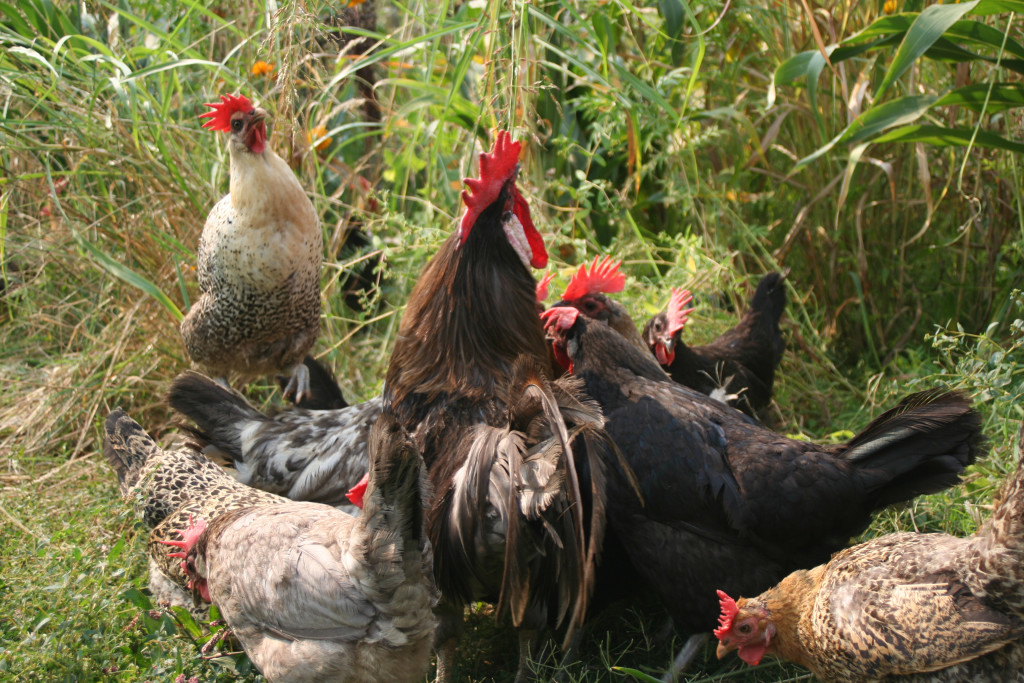 healthy chickens, allowing them a chicken-worthy life free ranging in a garden, scratching for bugs, with a safe spot to roost and lay their eggs, by doing that – a template is fortified, a way of life is given strength….a way of life in which animals who are living with humans for whatever reasons, are treated with respect, are cared for, seen and loved – a quantum entanglement with this, rather than some other worlds. There is beauty and communion and magic and health and grace and flow …..
healthy chickens, allowing them a chicken-worthy life free ranging in a garden, scratching for bugs, with a safe spot to roost and lay their eggs, by doing that – a template is fortified, a way of life is given strength….a way of life in which animals who are living with humans for whatever reasons, are treated with respect, are cared for, seen and loved – a quantum entanglement with this, rather than some other worlds. There is beauty and communion and magic and health and grace and flow …..